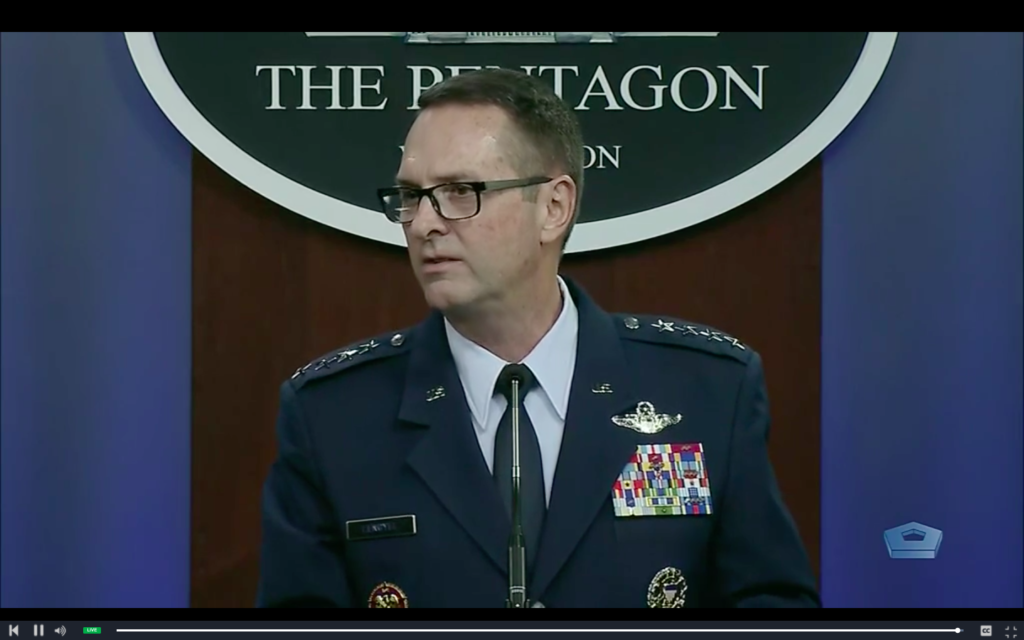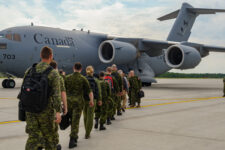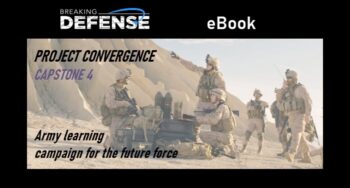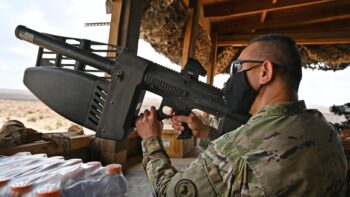
Gen. Joseph L. Lengyel, Chief of the National Guard Bureau, briefs reporters on COVID-19 response this morning.
UPDATED with Sen. Reed, Guard Association call for federal funds WASHINGTON: National Guard units across the country must remain available for local response to the coronavirus and should not be pulled away by a federal call-up, the Chief of the National Guard Bureau told reporters this morning.

The National Guard Association of the US (NGAUS) appealed to President Trump to fund state call-ups of the Guard.
Six Guard members have tested positive for COVID-19 so far, Air Force Gen. Joseph Lengyel said. (Army units have already cancelled training events across the country).
“Governors in 27 states have activated portions of their National Guard,” totaling 2,050 personnel, to deal with the coronavirus, Lengyel said. But he expects that number to climb rapidly, especially as more COVID-19 test kits become available for large-scale screening efforts.
UPDATE Thursday afternoon, the influential National Guard Association of the United States (NGAUS) wrote letters to President Trump and Congressional leaders calling on them to provide federal funding for state-level mobilization. “While SAD [State Active Duty] is an effective way to quickly mobilize the National Guard in absence of a federal emergency declaration, it is an inferior duty status given the lack of typical federal military support and benefits,” the letters said, but “federally funded Title 32 orders” would allow the governors to retain their full authority while providing financial support from Washington.
Sen, Jack Reed, the ranking Democrat on the Senate Armed Services Committee, made the same call on Thursday evening: “Governors are leading the fight, but they need more federal support, and the federal government should step up and pay the National Guard out of federal coffers.” UPDATE ENDS
What could more National Guard troops do?
“We can train members of the National Guard to actually administer the tests or support civilian medical professionals,” Gen. Lengyel said. The Guard also has its own medical gear, he said, but that “is a relatively small contribution when you look at the scope and scale of what this might be across the nation. There’s trucks and there’s helicopters and there’s buses and there’s all kinds of logistics capability,” he said. Above all, “what we bring is units, units of people that can do whatever task a governor might need them to do.”
“Every state adjutant-general [i.e. senior Guard officer] and every states’ joint force headquarters is thinking and planning about how to [respond]. They’re integrated with the public health services in every state, [and can send help in] a matter of hours,” he said.
Over and over, reporters pressed Lengyel on why the White House wasn’t ordering a nation-wide call-up. Over and over, Lengyel repeated – with increasing irritation – that federalizing Guard units would legally strip them of law enforcement authorities they only have when they’re under their governor’s command, although, he noted, there’s no “demand signal” yet for Guard troops to preserve order. Worse yet, federalizing Guard units, even if they were physically left in place in their home states, would organizationally unplug them from the state-run response.
“There’s no plan I’m aware to take the National Guards in the states and put them in federal status,” Lengyel said, and he’s advised Defense Sec. Mark Esper and Joint Chiefs Chairman Gen. Mark Milley against such a call-up.
“That would not make sense in this situation,” he said. “[Let’s] use the National Guard for the unique authorities that it has [when it can] remain under the command and control of the networks in the state. Every state has a different way to deal with disasters.”
“You can get everything that you need from the National Guard more effectively and more efficiently if you leave them in a state status,” he repeated. “If you mobilize all of the National Guard, it’s going to cost billions and billions and billions of dollars, and a lot of people won’t have things to do. There is no need to have 450,000 guardsmen on duty now in any given state.”
What’s more, many Guard troops are doctors, nurses, paramedics, police, and other essential occupations in their civilian lives, so mobilizing them indiscriminately and en masse would strip key personnel from the very public safety institutions most in need of help.
If a given state government is overwhelmed and needs more military help than its own National Guard units can provide, Lengyel said, the easiest way for them to get it is not by going to the Pentagon, but by asking their neighboring states for aid under long-established Emergency Management Assistance Compacts (EMACs). The role of the National Guard Bureau, which Lengyel heads, in this crisis is to support its state-level components and, where needed, help broker inter-state aid agreements, he said.
If federalizing the Guard doesn’t help in such a dire crisis, what’s the point of being able to federalize them at all? “If we were to go to war with a major peer competitor and you needed to grow the United States Army by 350,000,” Lengyel replied. (The Air Force would grow by 100,000 if it mobilized its Guard). “That is the World War II scenario.”
But that’s not the kind of crisis we are in right now. Coronavirus is a domestic natural disaster – albeit of a uniquely widespread and insidious kind.
“When there’s a hurricane, you can see it on a map, you have a sense of how hard the storm will hit,” Lengyel said. “COVID-19 is like we have 54 separate hurricanes in every state, territory, and the District of Columbia.”
Lithuania, Rheinmetall sign agreement for 155mm ammunition plant
“The establishment of the … ammunition factory in Lithuania will reduce our dependence on long supply chains, which currently pose great challenges in meeting the needs of the armies throughout the European Union and the world,” said Laurynas Kasčiūnas, Lithuania’s Minister of National Defense.


























